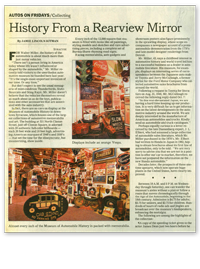
New York Times, Automobiles, October 1998
Interview with Walter Miller
|
|
||||
|
AUTOS ON FRIDAYS/Collecting
|
||||
|
|
||||
|
History From a Rearview Mirror
|
||||
|
|
||||
|
By JAMIE LINCOLN KITMAN
Syracuse
F
OR Walter Miller, the history of the automobile is about much more than just motor vehicles. "There isn’t a person living in America today whose life wasn’t influenced or shaped by the automobile," Mr. Miller recently told visitors to the unorthodox automotive museum he founded here last year. "It’s the single-most-important invention of our time. Or any time."
But don’t expect to see the usual menagerie of mint-condition Thunderbirds, Stutz-Bearcats and Sting Rays; Mr. Miller doesn’t believe that the vehicles themselves reveal as much about us as do the toys, publications and other accessories that are associated with the auto industry.
In fact, there are no cars on display at the Museum of Automobile History in downtown Syracuse, which houses one of the largest collections of automotive memorabilia and art. The building at 321 North Clinton Street, just off Clinton Square, is adorned with 20 authentic full-color billboards — each 20 feet wide and 10 feet high, advertising American marques of 1940’s and 1950’s — that set the tone for the idiosyncratic, but mesmerizing, show inside.
|
Every inch of the 12,000-square-foot museum is filled with items like oil paintings, styling models and sketches and rare advertising pieces, including a complete set of Burma-Shave rhyming road signs.
Racing memorabilia, auto gadgets and
|
showroom posters also figure prominently in the sprawling display, whose scope encompasses a newspaper account of a proto-automobile demonstration from the 1770’s and late-model designer renderings from Detroit.
Mr. Miller, 43, says a childhood interest in automotive history and world travel led him to a successful business as a dealer in automobile literature. His museum, for example, displays an interesting series of correspondence between the Japanese auto maker Toyota and Jerry McCullough, a former stylist for the Ford Motor Company who collected automotive sales brochures from around the world.
Following a request to Toyota for literature on Aug. 31,1948, Mr. McCullough received the following reply dated Oct. 7:
"In this war-devastated Japan, we are having a hard time keeping up our production. It is very difficult for us to get information on the latest developments in the automotive industry around the world. We are deeply interested in the manufacture of American automobiles and trucks. Kindly send us automobile and truck catalogues."
Perhaps equally curious is a letter received by the late Duesenberg expert, J. L. Elbert, who had amassed a large collection of automobile sales literature, which Mr. Miller purchased in the 1970’s. Mr. Elbert had written to Honda in Japan in 1962, hoping to obtain brochures about its first line of automobiles, only to be told: "We are very sorry to advise you that we are not in a position to offer our car to market, therefore, we have not prepared the information on the new Honda automobile."
Decades later, the prospects of these onetime upstarts, which now operate huge plants in the United States, have clearly improved.
• • •
Between 10 A.M. and 5 P.M. on Wednesday through Saturday, one can wander the museum’s aisles without a plan or follow a route that moves chronologically through the Age of the Automobile, beginning in the 18th century. Admission is $4.75 for adults; $3.75 for seniors, and $2.75 for children. Hundreds of hours of radio ads and jingles are broadcast over the museum’s loudspeakers, enhancing the nostalgia.
The following are among the highlights of the collection:
|
||
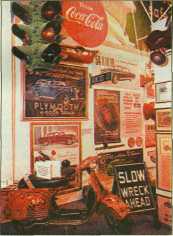 |
||||
|
Displays include an orange Vespa.
|
||||
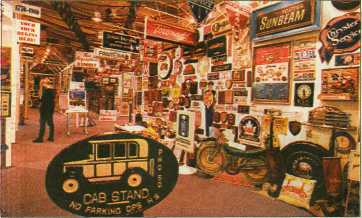 |
||||
|
Almost every inch of the Museum of Automobile History in packed with memorabilia.
|
||||
|
|
||||
|
|
|||
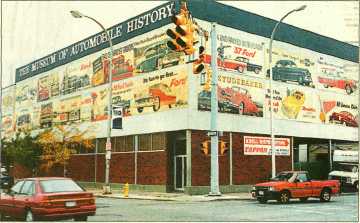 |
|||
|
|
|||
|
Photographs by Michael J. Okoniewski for The New York Times
Billboards from the 1940’s and 50’s set the tone for the downtown Syracuse museum.
|
|||
|
|
|||
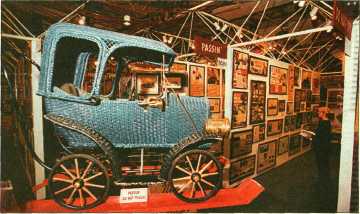 |
|||
|
|
|||
|
A baby carriage in the form of a car from the industry’s youth early in the century.
|
|||
|
|
|||
|
was killed in a crash on Sept. 30,1955.
•An original poster for the 1895 Paris-to-Bordeaux Race and the Paris Automobile Exposition, one of the first car races and the first auto show.
•Original Art Deco renderings done by automotive stylists for the Cadillac V16 and Surrealist Cadillac prints by Salvador Dali.
•Original United States patents for the Daimler-Benz and Duryea automobiles.
•Psychedelic showroom posters for Plymouths and Dodges from 1969 and 1970.
•The Car-B-Que, a 1958 auto accessory
|
that allowed motorists to cook hot dogs in their moving vehicles.
•Walter Chrysler’s 1924 registration for the first Chrysler and his driver’s license.
In storage rooms beneath the museum galleries, Mr. Miller has piles of unsorted material, ranging from Ford company archives from the late 1940’s (they apparently left Detroit with a disgruntled vice president) to job-lot stocks of Opel Kadett sales material to film strips aimed at helping De-Soto dealers bolster sales.
This clearly is a place where history arrives by the crate load almost daily.
|
||
|
|
|||


